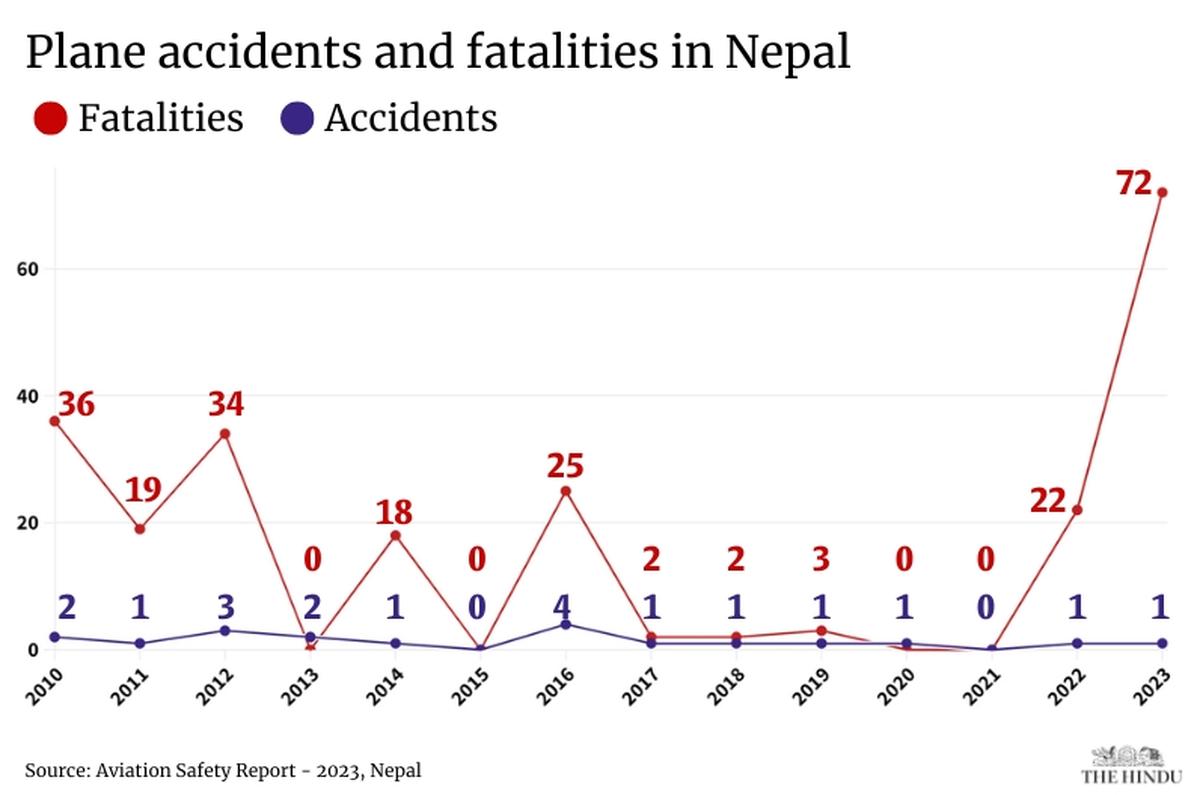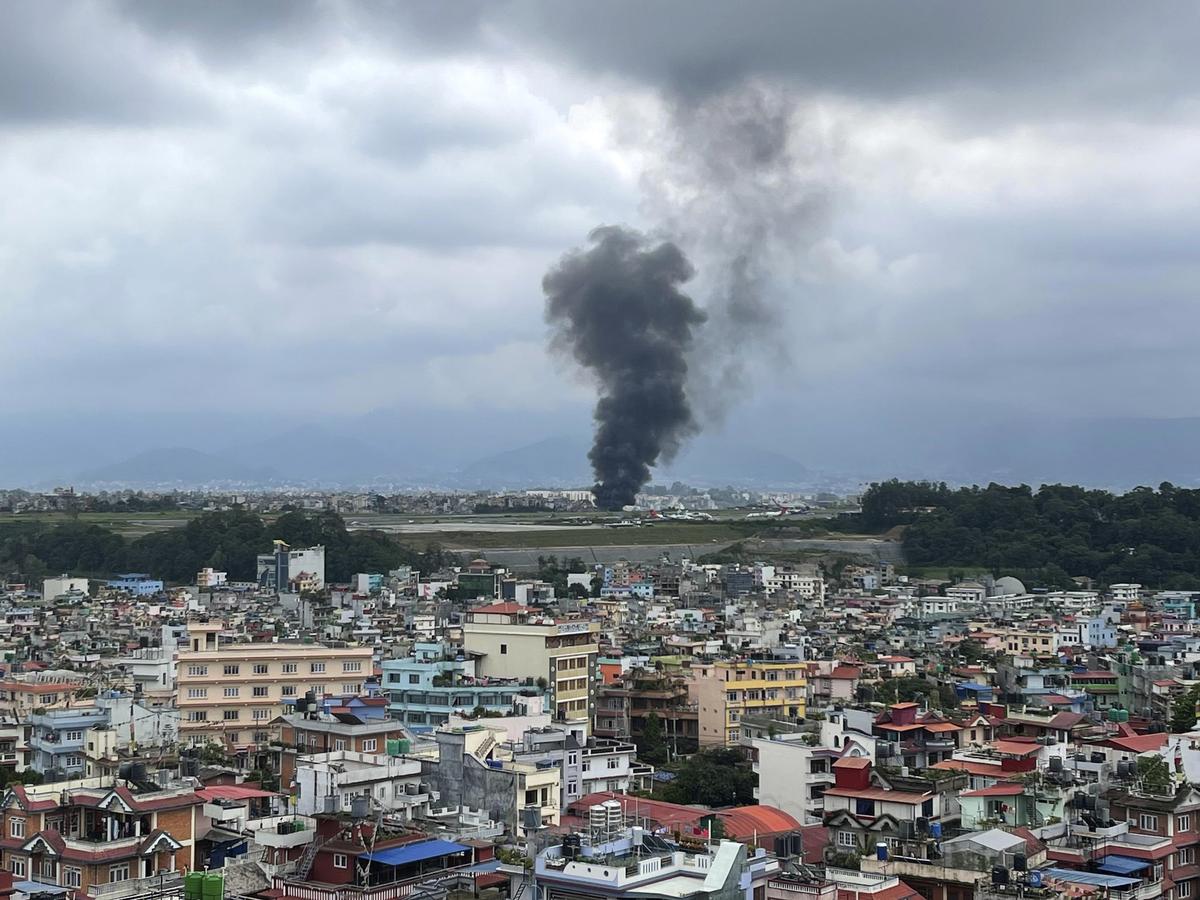When Manu Raj Sharma, a technician with Saurya Airlines, boarded his company’s aircraft with his wife Priza Khatiwada and four-year-old son Adhiraj on Wednesday morning, the Kathmandu sky was clear after an overnight rain, perfect for a regular flight.

There were 15 others onboard the plane, including three crew members.
Around 11 a.m., the 50-seater Bombardier CRJ-200 jet was cleared for takeoff from the Tribhuvan International Airport from the southern end of the runway (Runway 02). It was bound for the tourist town of Pokhara, a 25-minute flight west of Kathmandu.
But shortly after the takeoff, at 11:11 a.m., the aircraft veered off the runway, banking to the right, and plunged into a gorge on the east of the airstrip. In no moment, it was a ball of fire. A huge plume of smoke billowed out.
Rescue operations were initiated immediately and the fire was brought under control. But 18 people, including the Sharma family, had already died.
“One injured person (Captain Manish Ratna Shakya) was rescued and 18 people were found dead,” said the Civil Aviation Authority of Nepal (CAAN) in a statement.
All aboard the plane were Nepalese except one, who has been identified by CAAN as a Yemeni national.
Worst disasterThis is the most disastrous plane accident in Nepal in 18 months, since its worst domestic aviation disaster on January 15 last year when a Yeti Airlines plane from Kathmandu crashed a few minutes before landing at the newly built Pokhara International Airport, killing all 72 people onboard, including the crew. The previous year in May, 22 people died when a Tara Air plane en route from Pokhara to the tourist destination of Jomsom slammed into a mountain. Besides 16 Nepalese, including three crew, there were four Indian and two German nationals in the plane.

Wednesday’s crash is the 105th in Nepal since the country recorded its first air disaster in August 1955. According to Nepal’s civil aviation authority, 914 people had died in air disasters until 18 people perished in the latest Saurya Airlines fatal crash.
Some of the airports in Nepal’s mountain regions are quite tricky to land on and quickly changing weather conditions pose an additional challenge even for the accomplished pilots. Wednesday’s case was different though. The Saurya plane was set to fly from one of the most equipped airports in the country to another in perfect weather conditions.
Detailed checkSmoke rises from the Tribhuvan International Airport in Kathmandu, Nepal, on July 24, 2024. State television in Nepal says a plane has slipped off the runway and crashed while trying to take off from Kathmandu airport | Photo Credit: AP
The Saurya Airlines 9N-AME plane on Wednesday was on a non-scheduled flight. Airline officials said the aircraft was heading to Pokhara for a comprehensive inspection called C Check, which is carried out every 18 to 24 months. The company had booked one of the hangars at the Pokhara International Airport where its technicians were scheduled to conduct the inspection.
According to Flightradar24 flight tracking, the plane was built in 2003. It was handed over to Saurya in 2017. “The aircraft was not equipped with a modern ADS-B transponder, so it was not tracked on Flightradar 24,” the flight tracker wrote on X, immediately after the crash.
CAAN said it had 50 to 60 hours of flying time remaining before the scheduled inspection.

Saurya Airlines’ passenger manifest initially had identified all aboard the plane as company staff, only to make it clear later that the wife and son of a technician were also among the passengers.
Established in 2014, the company had been going through a rough patch recently and its planes were even grounded in 2018 for failing to pay debts to the airport.
Questions had been raised about its safety standards for skipping even regular inspections. According to the company website, the airline operates flights to five destinations with a fleet of three Bombardier CRJ-200 jets. But it was operating only one aircraft of late.
In May last year, it issued a notice about laying off staff in view of its bad financial health and scaling down operations.
Poor recordWednesday’s crash once again has brought to the fore the oft-asked question about Nepal’s poor air safety record due to which the European Commission (EC) has imposed a ban on Nepalese airlines in European skies for more than a decade. The EC and the United Nations International Civil Aviation Organisation (ICAO) have repeatedly called on Nepalese authorities to split CAAN so that there would be a clear distinction between two entities — one as the operator and the other as regulator. Currently, CAAN functions as both.
But to split the civil aviation body, new laws are required. Amid repeated calls from the EC and ICAO, the Nepal government on February 23, 2020 had registered two bills in Parliament. They were passed by the Upper House on August 2, 2021, but the successive governments and Ministers, despite their promises to get the bills through the lower house, have shown little interest in doing so.

The EC imposed a blanket ban on Nepalese airlines from flying into the 28-nation bloc following a Sita Air plane crash in September 2012 near Kathmandu airport, minutes after takeoff. All 19 people onboard, including seven British citizens, died. An already concerned EC then banned Nepalese airlines from entering Europe, saying not much was being done to improve the air safety standards despite repeated incidents of air crashes.
Lax regulations are to blame for Nepal’s poor air safety record, and as long as the CAAN is not bifurcated, the situation is unlikely to improve, says Hemant Arjyal, who has closely followed Nepal’s aviation sector and written extensively on the subject for years.
“The bills have failed to get through the Parliament because of politicians as well,” he said. “Either they have absolutely no idea about what purpose the bifurcation of the CAAN serves or they are getting some benefits because the aviation body performs the dual role.”
Outrage in NepalNepalese were enraged by Wednesday’s crash, blaming politicians for their apathy toward the frequent plane crashes as well as road accidents. Many took to social media to ask why Nepal has yet to split the CAAN so as to ensure air safety, as they called out politicians for failing to work in earnest to prevent the deaths of fellow citizens in the skies and on the roads.
Prime Minister K.P. Sharma Oli’s visit to the crash site on Wednesday afternoon further angered the public, who questioned the rationale behind such visits to accident sites and dubbed it “disaster tourism” by politicians.
Mr. Oli was appointed Prime Minister on July 14, two days after his predecessor Pushpa Kamal Dahal ‘Prachanda’ lost his vote of confidence. People’s anger was directed at politicians also because the day Mr. Dahal was seeking a vote of confidence on July 12, two buses carrying more than 60 people had plunged into the swollen Trishuli river in Chitwan. Search is still on to find the bodies.
Nepalese were further angered by the Oli government’s decision to fly the flag at half-mast on Thursday in memory of those killed in the plane crash, as they pointed at the State’s discrimination between those killed in air disasters and road accidents.
Probe beginsAn emergency Cabinet meeting on Wednesday decided to form a probe committee to investigate the Saurya Airlines crash. “A five-member committee has been set up under the leadership of Ratish Chandra Lal Suman, former director general of CAAN,” said Communications Minister Prithvi Subba Gurung, who is also the government spokesperson. “The committee has been given 45 days [to submit its report].”

















































